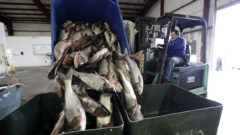Illinois and Army Corps at an impasse over building barrier to prevent invasive carp

By Juanpablo Ramirez-Franco, WBEZ
This coverage is made possible through a partnership between WBEZ and Grist, a nonprofit, independent media organization dedicated to telling stories of climate solutions and a just future. Sign up for WBEZ newsletters to get local news you can trust.
Great Lakes Now
https://www.greatlakesnow.org/2024/03/illinois-and-army-corps-at-an-impasse-over-building-barrier-to-prevent-invasive-carp/






















